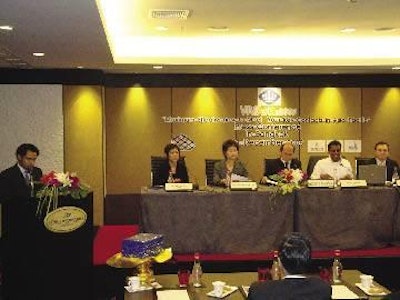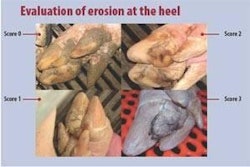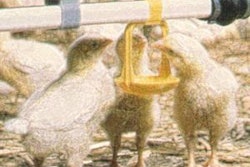
A pre-show visit to Thailand ahead of the VIV Asia exhibition has provided journalists from Asia and Europe with the opportunity to update Asian industry developments as 2009 arrives.
VIV Asia 2009 takes place 11-13 March at the Bitec show ground in Bangkok. From a presentation to the press party by show manager Ruwan Berculo, the event will contain about 500 suppliers as exhibitors and it aims to have between 20,000 and 22,000 visitors. Based on past performance for the series, the attendance will represent at least 70 countries, he explained, with about half of all visitors coming from outside Thailand.
As a subsequent tour of farms and facilities confirmed, the financial credit squeeze hitting western countries has had less effect so far on business in Asia. A local report referred to Asian banks as being bruised but not collapsing or needing bail-out support from their respective governments. This is said to be due to the 1997-98 financial crisis, which left balance sheets and public finances on a sounder footing, with tight supervision of banks and good risk-management systems.
Central banks in the region have also won praise for their actions on interest rates and liquidity since the western banking problems surfaced in the third quarter of last year. Asian lenders, meanwhile, find themselves in a good position, with enough money to take advantage of any market opportunities once the global situation stabilises.
Investment announcements
Thailand itself supplied an example of the mood among agrifood businesses at the time of the tour, when pork integrator Betagro Group announced it would be investing some 320 million Thai Baht (about US$9.4 million) on expansion into pig projects in neighbouring Cambodia and Laos. Each country is to have a breeding herd with capacity for 2,000 pigs and costing around 160 million Baht. Narongchai Srisantisaeng, senior vice-president for regional and feed business at Betagro's headquarters, also becomes managing director of satellite companies founded for the two countries.
He said the group opened a representative office in Cambodia in September 2008 because of developing sales of feed to Cambodian units. So far, the feeds have been supplied from Betagro's Thai mills at a rate of 2,000 metric tons per month. But with a projected doubling in sales to 4,000 metric tons per month, it now plans to spend 300 million Baht on building a new feedmill inside Cambodia which can produce 72,000 metric tons per year to the local market. Laos will continue to be sourced with feeds from Thailand, currently at about 600 metric tons per month for Laotian livestock and increasing at 5-6% per year.
Other remarks by Narongchai underlined the impression of further growth possibilities with the stabilising of the global economy. For example, he said Betagro was now producing some 1.65 million metric tons of feeds from eight plants after opening a new feedmill in November at Lamphun in Thailand. This plant has cost about 370 million Baht. The target for 2009 is 1.75 million metric tons. A further budget of up to 1 billion Baht has since been agreed for use within the next three years on constructing another mill in the south-western Thai provinces of Phetchaburi or Ratchaburi.
Growth in feed sales
For 2009, the group is projecting an increase in its feed sales from 11 billion Baht to 12 billion Baht following a 10% rise in 2008. Less than half of the feed it produces is sold on the open market. The main part goes to integrations. Narongchai predicts both sectors will be boosted in Thailand this year by feed price reductions due to a halving of the import tax levied on soya bean meal and lower prices for grains. The firm seeks to grow sales from 2009 until 2011 at an annual average rate of 30%.
Another Thai integrator in expansion mode is GFPT, which produces feeds for pigs and poultry under the Krung Thai brand. Managing Director Anan Sirimongkolkasem said its feed manufacturing facilities are "running at full capacity" of 400,000 metric tons per year and a new mill will be opened next year in Thailand's Chonburi province.
Investments in higher health are leading the way at the most well-known name in Thai agribusiness, Charoen Pokphand Foods or CPF. It is closely involved in the first of the country's compartments, or areas of controlled health for meat exporting purposes. Simultaneously, there is a CPF programme to add to the number of PRRS-free pig units in its pork network.
Emphasis on biosecurity
Also called zoning, compartmentalisation in Thai terms seeks to create a defined area of the country in which health surveillance and biosecurity on audited enterprises are managed for the specific purpose of providing products that are acceptable for international trade. The initial examples nationally are dedicated to poultry meat and involve both CPF and GFPT, but similar principles are under review for developing pork export sales.
"Livestock production must be based on the international standards requiring that it is hygienic, safe and fit for human consumption," remarked Sinchai Ruengpaiboon of the department of livestock development at Thailand's Ministry of Agriculture. "The Thai livestock industry has strength in supplying products to the world market with a reliable and acceptable quality.
"Chicken and pork are the product champions. For 2008, the value of the sector in Thailand was about 302 billion Baht. Of this, chicken and pork had values of 90 billion Baht and 97 billion Baht, respectively.
"The value of livestock production in Thailand increased 18.3% in 2008. Although the world is in slowdown, Thailand's livestock industry is expected to continue growing in 2009 [at an] estimated at 2.2%."
Foreign operations
Exports and foreign operations, as well as activities within Thailand, have given CPF sales of around 150 billion Baht in 2008. Russia became one of its newest locations about two years ago and now it is building a Russian pig breeding network that will have 2,400 sows at great-grandparent (GGP) level and a multiplication GP inventory of 15,000 sows. For CPF, too, there has been an entry into Laos with the construction of a first breeding site there. Besides building more PRRS-free herds inside its home country, the firm has developed plans to have further sites with the same health status in China.
There are other large Chinese projects in sight, the pre-show journalists' tour was reminded. Yurun Foods seeks to raise its slaughtering capacity from a present level of 18 million pigs per year to 50 million pigs per year by 2012. Bigger China players believe they have of room to grow as small operators struggle in the fast-changing food market.
Asia's potential can also be seen in Korea, where a domestic production of about 726,000 metric tons of pork per year is contrasted with a consumption of almost 931,400 metric tons annually. The government is encouraging local producers to devote efforts towards marketing branded pork. Feed manufacturers from the country look outward as well for their growth, developing mills in Cambodia and the Philippines.
Thai sources say their country's annual feed requirements are assessed as being for the production of around 15 million pigs and 750 million chickens per year. Sow numbers nationally may have slipped towards 900,000 recently as some smaller herd-owners exit, although expansionary moves by big integrators look ready to restore a level of one million sows in the coming months.















